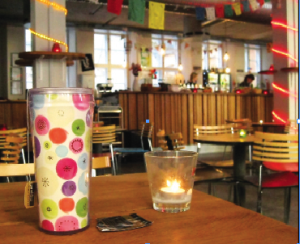
Given that we are mere days away from the 1st of April as I write this and having failed to yet discuss the Danish concept of Hygge, I had feared I might not get to it at all. As the key to survival during the cold, dark winter months, I did not expect Hygge to make much sense as a topic for my first spring column. But today, just two days before April, it is snowing yet again, which makes this discussion seem like a perfect choice.
There is no literal translation for the word hygge (pronounced roughly like hoo-ga), but the best one-word definition I can offer is “cozy” (though that is grossly inadequate). Hygge can be a noun, an adjective or a verb and is used in countless realms of Danish life. A home, a city, an afternoon, a conversation or a piece of furniture can all be described as Hyggeligt. One of the first phrases that I learned in my Danish class was, “Jeg hygger mig” (the equivalent of “I cozy myself”), and then, “Hyg dig!” (“Have a cozy time!”). And while the sensation of physical comfort and “coziness” is certainly a part of its meaning, hygge also connotes a general feeling of warmth, affection, happiness, satisfaction, relaxation, serenity and togetherness. It’s taken me some time to solidify my own understanding, but the process was made easier by life with my Danish host-family (who have grown up knowing and living a life full of hygge).
In fact, it was in my Danish home that I first began to experience the concept. It is made hyggeligt by the fireplace that is always burning, the candles around the living room and the blankets and pillows for snuggling on the couch. Our evenings and weekends are hyggeligt, spent together around the dining room table or sitting watching a movie as we feast on sweets. Because there is really only one room to spend time in other than the bedrooms, we are always together in the living room: I do homework, Kasper (host-brother) reads, Mira (host-sister) does art, my host-father may be watching football, etc. Even Balou and Junior (our two chocolate labs) practice the verb form of hygge, and are constantly cuddled together in front of the fireplace.
Early into my semester, my host mother explained that Danes don’t enjoy the winter weather, but they do enjoy togetherness. They enjoy warm scarves and fuzzy hats, drinking tea and hot beverages, dim candlelight, long dinners and delicious breakfasts, time with family and visits with friends. Understanding, practicing and feeling hygge has helped me to better understand Danish happiness, a topic both of my studies abroad and of my columns here. Denmark’s place at the top of the list of the Happiest Countries on Earth used to perplex me — especially because of the weather– but the more that I’ve come to know and practice hygge, the more it makes sense.
In Denmark, as a temporary member of a society that emphasizes feeling comfortable, satisfied, cozy, warm and happy together, I have come to see that winter weather doesn’t have to be accompanied by a sense of constant gloom. In the US, I feel as though I am in a perpetual rush, a frenetic pace that does not slow down during the winter months. I am always hurrying from one place to the next, only to arrive and then bundle up to rush out again. Unless it is built into my schedule, I rarely make time to sit, relax, curl up with a book in front of the fire or linger at the dinner table. I’ve now begun my search for things I can bring home when I return from Denmark in just six weeks; hygge is right at the top of my list.


